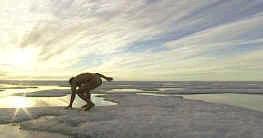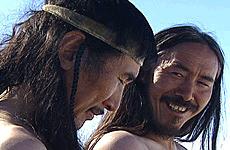Atanarjuat (The Fast Runner)


Atanarjuat, the first film ever filmed in the Inuit language of Canada, is a stunning achievement. It gives movie audiences a glimpse of an old culture for the first time, in a story that is fresh yet familiar, because it touches on such basic human emotions as love, hatred, jealousy, and revenge. The story itself, written by Paul Apak Angilirq, is based on an ancient Inuit tale. It unfolds over nearly three hours, which may be a little too long, but this allows people to fully enmesh themselves into this new, barren world. Atanarjuat won the Golden Camera at the 2001 Cannes Film Festival, as well as a whopping five awards at the 2001 Genie Awards (the Canadian equivalent of the Oscars, ay), including Best Picture, Best Director (Zacharias Kunuk) and Best Screenplay.
The film details the effects of a curse thrown in the prior generation. It all falls upon Atanarjuat (Natar Ungalaaq, Kabloonak), one of the fastest runners in a group of Inuit. He lives with his brother Amaqjuaq (Pakkak Innushuk) and is in love with Atuat (Sylvia Ivalu). The problem is that Atuat is promised to Oki (Peter-Henry Arnatsiaq), the son of Sauri (Eugene Ipkarnak), the chief of the community. The curse's evil resides in Oki, who is resents Atanarjuat's affections towards Atuat. Oki eventually loses Atuat to Atanarjuat, which causes Oki's hatred to grow. Atanarjuat also marries Puja (Lucy Tulugarjuk), Oki's sister.
As events unfold, the evil rears its power through Oki and Puja, and leads to Atanarjuat fleeing the community. The most memorable scene of the movie is when Atanarjuat is fleeing from Oki, running naked across a crumbling glacier. This scene is so simple yet loaded with meaning. He is running for his life, or what is left of it as a result of the curse. The acting is so naturalistic that it feels as if a camera was spying on the lives of these Inuit instead of a group of actors reciting lines. Extended sequences of everyday events buffer the running time, but Kunuk also uses them to show what life was like for these people. They lives simple lives, and when hatred becomes a part of it, everything becomes infinitely more complicated. The movie drags in more than one place, but is still able keep the interest of anybody watching for most of it, which is definitely a good thing.
The look of Atanarjuat is the most compelling thing about the film. It was shot on digital then transferred to film, which gives some of the movie an eerie, otherworldly quality to it. The lights reflect off the ice, water and fire hazily, giving things auras. The sound of boots crunching on ice is a constant, and the awkward movements of these people as they bundle themselves in furs and try to move actually makes the viewer feel cold. Snow and water, and occasionally dirt, stretch for miles to the horizon. Atanarjuat is a beautiful movie look at. Although its culture may be new, its universal themes ensure that people everywhere can enjoy it.